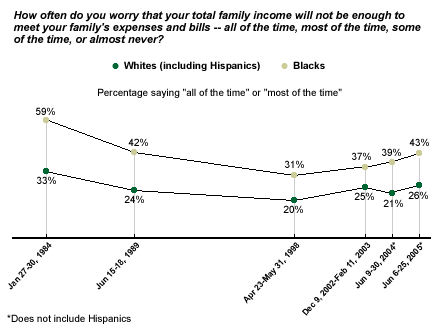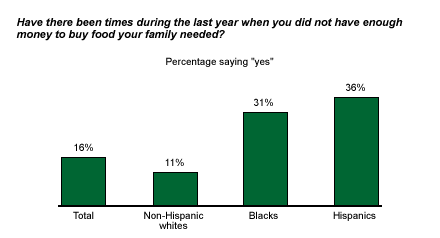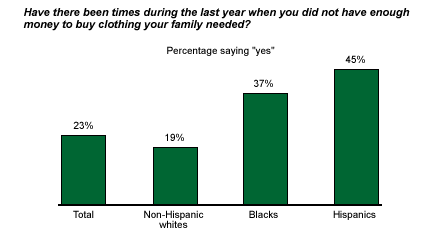The cover story of the February 2005 issue of Black Enterprise magazine, which honored the 75 most influential blacks in corporate America, featured 18 black CEOs of powerful companies such as American Express, Time Warner, and Merrill Lynch. In 1993, there were only two black CEOs on the list. U.S. Census figures also suggest progress among minority communities: In 2003, 22% of black families lived below the poverty line, down from 31% a decade before. Among Hispanic families, the number dropped similarly, from 27% in 1993 to 21% in 2003. During the same time, the percentage of white families was steadier -- 9% lived below the poverty line in 1993, compared with 8% in 2003.
Despite that progress among blacks and Hispanics, data from Gallup's June 2005 Minority Relations poll* reveal that minorities still have singularly different life experiences from their white counterparts. Blacks and Hispanics are much more likely than whites to express concern about their personal finances, and to say they struggle to meet the most basic needs.
Gallup asked respondents how often they have to worry that their family incomes will not be enough to cover their expenses and bills. Forty-three percent of blacks say this is a concern they must face "all" or "most of the time"; only 26% of whites express the same degree of concern.

Forty-one percent of Hispanics say they worry about meeting their bills and expenses "most" or "all of the time."
Worry Over Basic Necessities
Beyond their concern about their finances, blacks and Hispanics also differ significantly from whites in their reports of being unable to meet some basic needs. For example, 36% of Hispanics and 31% of blacks say there have been times in the last year when they did not have enough money to buy food their families needed. That compares with just 11% of whites.

The same holds true for the question about whether respondents have had enough money to buy clothing for their families. Forty-five percent of Hispanics and 37% of blacks say there have been times in the last year when they did not have enough money to buy clothing; just 19% of non-Hispanic whites say the same.

Bottom Line
Despite decades of reform, activism, and economic progress, many minorities still struggle for basic necessities. These data illustrate the fact that the American dream continues to elude a significant proportion of the U.S. population.
*Results are based on telephone interviews with 2,264 national adults, aged 18 and older, conducted June 6-25, 2005, including oversamples of blacks and Hispanics that are weighted to reflect their proportions in the general population. For results based on the total sample of national adults, one can say with 95% confidence that the maximum margin of sampling error is ±5 percentage points.

